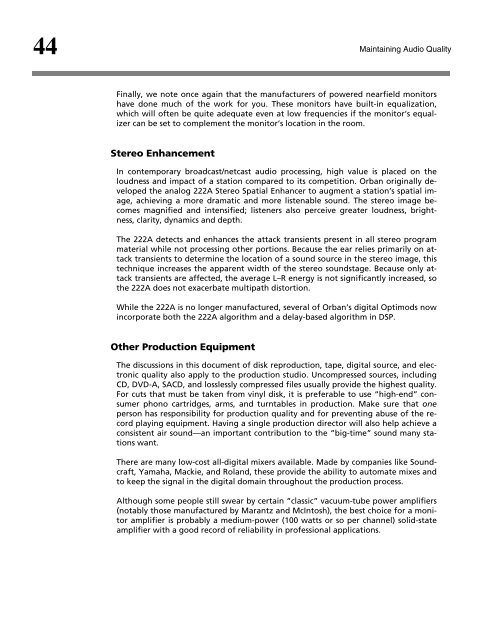Maintaining Audio Quality in the Broadcast Facility 2011 - Orban
Maintaining Audio Quality in the Broadcast Facility 2011 - Orban
Maintaining Audio Quality in the Broadcast Facility 2011 - Orban
Create successful ePaper yourself
Turn your PDF publications into a flip-book with our unique Google optimized e-Paper software.
44<br />
<strong>Ma<strong>in</strong>ta<strong>in</strong><strong>in</strong>g</strong> <strong>Audio</strong> <strong>Quality</strong><br />
F<strong>in</strong>ally, we note once aga<strong>in</strong> that <strong>the</strong> manufacturers of powered nearfield monitors<br />
have done much of <strong>the</strong> work for you. These monitors have built-<strong>in</strong> equalization,<br />
which will often be quite adequate even at low frequencies if <strong>the</strong> monitor’s equalizer<br />
can be set to complement <strong>the</strong> monitor’s location <strong>in</strong> <strong>the</strong> room.<br />
Stereo Enhancement<br />
In contemporary broadcast/netcast audio process<strong>in</strong>g, high value is placed on <strong>the</strong><br />
loudness and impact of a station compared to its competition. <strong>Orban</strong> orig<strong>in</strong>ally developed<br />
<strong>the</strong> analog 222A Stereo Spatial Enhancer to augment a station’s spatial image,<br />
achiev<strong>in</strong>g a more dramatic and more listenable sound. The stereo image becomes<br />
magnified and <strong>in</strong>tensified; listeners also perceive greater loudness, brightness,<br />
clarity, dynamics and depth.<br />
The 222A detects and enhances <strong>the</strong> attack transients present <strong>in</strong> all stereo program<br />
material while not process<strong>in</strong>g o<strong>the</strong>r portions. Because <strong>the</strong> ear relies primarily on attack<br />
transients to determ<strong>in</strong>e <strong>the</strong> location of a sound source <strong>in</strong> <strong>the</strong> stereo image, this<br />
technique <strong>in</strong>creases <strong>the</strong> apparent width of <strong>the</strong> stereo soundstage. Because only attack<br />
transients are affected, <strong>the</strong> average L–R energy is not significantly <strong>in</strong>creased, so<br />
<strong>the</strong> 222A does not exacerbate multipath distortion.<br />
While <strong>the</strong> 222A is no longer manufactured, several of <strong>Orban</strong>’s digital Optimods now<br />
<strong>in</strong>corporate both <strong>the</strong> 222A algorithm and a delay-based algorithm <strong>in</strong> DSP.<br />
O<strong>the</strong>r Production Equipment<br />
The discussions <strong>in</strong> this document of disk reproduction, tape, digital source, and electronic<br />
quality also apply to <strong>the</strong> production studio. Uncompressed sources, <strong>in</strong>clud<strong>in</strong>g<br />
CD, DVD-A, SACD, and losslessly compressed files usually provide <strong>the</strong> highest quality.<br />
For cuts that must be taken from v<strong>in</strong>yl disk, it is preferable to use “high-end” consumer<br />
phono cartridges, arms, and turntables <strong>in</strong> production. Make sure that one<br />
person has responsibility for production quality and for prevent<strong>in</strong>g abuse of <strong>the</strong> record<br />
play<strong>in</strong>g equipment. Hav<strong>in</strong>g a s<strong>in</strong>gle production director will also help achieve a<br />
consistent air sound—an important contribution to <strong>the</strong> “big-time” sound many stations<br />
want.<br />
There are many low-cost all-digital mixers available. Made by companies like Soundcraft,<br />
Yamaha, Mackie, and Roland, <strong>the</strong>se provide <strong>the</strong> ability to automate mixes and<br />
to keep <strong>the</strong> signal <strong>in</strong> <strong>the</strong> digital doma<strong>in</strong> throughout <strong>the</strong> production process.<br />
Although some people still swear by certa<strong>in</strong> “classic” vacuum-tube power amplifiers<br />
(notably those manufactured by Marantz and McIntosh), <strong>the</strong> best choice for a monitor<br />
amplifier is probably a medium-power (100 watts or so per channel) solid-state<br />
amplifier with a good record of reliability <strong>in</strong> professional applications.



![[PDF] Using the ITU BS.1770-2 and CBS Loudness Meters ... - Orban](https://img.yumpu.com/50629372/1/190x245/pdf-using-the-itu-bs1770-2-and-cbs-loudness-meters-orban.jpg?quality=85)






![[PDF] Optimod-FM Feature Comparison - Orban](https://img.yumpu.com/41741615/1/190x245/pdf-optimod-fm-feature-comparison-orban.jpg?quality=85)






